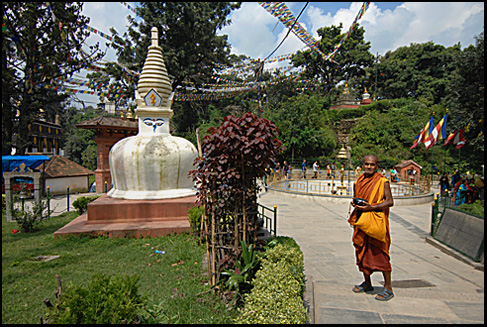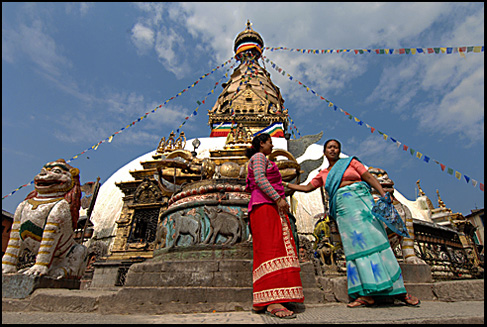Swayambhunath is an ancient Buddhists stupa, three km west of downtown Kathmandu, said to be 2,000 years old. On this Stupa, which is surrounded by over 200 praying wheels, are the famous all seeing eyes of Buddha, which are easily recognizable. What looks like a nose is the Nepali number one, which represents the unity of all things.
Swayambhunath is on top of a 77m (240 feet) hill. It takes about 20 minutes to walk up the 365 stairs. There is an excellent view of the Kathmandu valley and the surrounding mountains from here. Swayambhunath is also known as the Monkey Temple as there are holy monkeys living in parts of the temple in the north-west. They are holy because Manjushree, the bodhisattva of wisdom and learning was raising the hill which the Swayambhunath temple stands on. He was supposed to leave his hair short but he made it grow long and head lice grew. It is said that the head lice had transformed into these monkeys.
The Kathmandu Valley is believed by geologists to have been a huge lake and the Swayambhunath was an island in the lake. It is said that Emperor Ashok visited this place 2000 years ago. King Manadeva instructed that some work by done here in 460 AD. It has an important Buddhist site by the 13th century. Muslims invaders broke open the stupa in 1346. In the 17t century the stairway up to the stupa was constructed by King Pratap Malla.
You can reach the stupa by taking the western entrance, the more interesting and more difficult way to reach the stupa is climbing the eastern stairways. At the base of the hill is a brightly painted gateway. Within the gatehouse there is a large prayer wheel, almost 4m (12 ft) tall, which strikes a bell when it goes around. It is believed that if you spin a prayer wheel that all the prayers written inside are recited and send upward to heaven. Near the beginning of the stair there is a stone footprint, which is said to be either that of the Buddha or of Manjushri.
On top of the high central stupa on a golden colored square of the all watchful eyes of the Buddha looking in all four directions. The noise is actually the Nepali number one, and it symbolizes unity. Between the two normal eyes is a third eye above that symbolizes the clairvoyant powers of the Buddha. The base represents the four elements — earth, water, fire and air. The 13 levels of the spire represent the 13 steps to realization that leads to nirvana, which the umbrella symbolizes.
Around the base of the stupa are prayer wheels that pilgrims spin while walking around the stupa. There are prayer flags on the lines connected to the spire which has mantras on them which in the winds take the words away. Although the site is considered Buddhist, the place is revered by both Buddhists and Hindus. Numerous king Hindu followers are known to have paid their homage to the temple. The stupa was completely renovated in May of 2010, its first major renovation in 90 years and its 15th in the nearly 1,500 years since it was built. The dome was re-gilded using 20 kg of gold. Each morning before dawn, hundreds of Buddhist (Vajrayana) and Hindu pilgrims ascend the 365 steps that lead up the hill, passing the gilded Vajra and two lions guarding the entrance, and begin a series of clockwise circumambulations of the stupa.








Wow! Stunning photos. I dream of traveling Nepal and this post just confirmed why. Can’t wait to check out more of your site/blog.